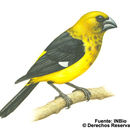pms
nòm ant ël fil


The black-thighed grosbeak (Pheucticus tibialis) is a large seed-eating bird in the cardinal family, which is endemic to the mountains of Costa Rica and western Panama.
This species breeds from about 1,000 m (3,300 ft) altitude (Pacific slope) or 1,500 m (4,900 ft) (Caribbean slope) up to 2,600 m (8,500 ft) and is found in canopy, woodland edge and semi-open habitats such as pasture with some trees. The nest is a thin cup constructed on a bulky twig base 1–3 m (3.3–9.8 ft) up in a small tree or amongst vines. The female lays two brown-spotted pale blue eggs between March and May.
The adult black-thighed grosbeak is 20 cm (7.9 in) long, weighs 70 g (2.5 oz), and has a massive grey bill. The male has a yellow head, rump and underparts, an olive-edged black back, and black wings, thighs and tail. There is a white patch on the flight feathers. The female is paler with more olive on the back and a smaller white wing patch. Immatures are duller and more olive-tinged, and have streaking and mottling on the body plumage.
The black-thighed grosbeak forages in shrubs or trees for insects, seeds and berries. The call is a sharp pink, and the song is a musical stream of warbles, whistles, trills and slurs.
The black-thighed grosbeak (Pheucticus tibialis) is a large seed-eating bird in the cardinal family, which is endemic to the mountains of Costa Rica and western Panama.
This species breeds from about 1,000 m (3,300 ft) altitude (Pacific slope) or 1,500 m (4,900 ft) (Caribbean slope) up to 2,600 m (8,500 ft) and is found in canopy, woodland edge and semi-open habitats such as pasture with some trees. The nest is a thin cup constructed on a bulky twig base 1–3 m (3.3–9.8 ft) up in a small tree or amongst vines. The female lays two brown-spotted pale blue eggs between March and May.
The adult black-thighed grosbeak is 20 cm (7.9 in) long, weighs 70 g (2.5 oz), and has a massive grey bill. The male has a yellow head, rump and underparts, an olive-edged black back, and black wings, thighs and tail. There is a white patch on the flight feathers. The female is paler with more olive on the back and a smaller white wing patch. Immatures are duller and more olive-tinged, and have streaking and mottling on the body plumage.
The black-thighed grosbeak forages in shrubs or trees for insects, seeds and berries. The call is a sharp pink, and the song is a musical stream of warbles, whistles, trills and slurs.